

Historical city travel guide: London, late 16th century. Bird's eye view of the City of London from Hampstead to St.
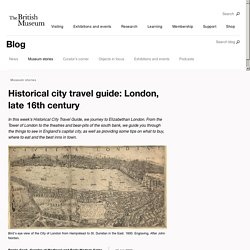
Dunstan in the East. 1600. Engraving. After John Norden. Location London sits in the fertile south-east of England at an ancient crossing point of the River Thames. London is currently the largest city in the country by a huge margin, with a population heading towards 200,000 (probably ten times the population of its nearest rivals – Norwich, Bristol and York), and this dominance has been the case pretty much from the time the kingdom of England itself came into being in the 11th century. When to visit The climate is temperate and liveable throughout the year, even in the Little Ice Age. The best time to visit is probably autumn or spring – the court and players are back and plague retreats. Getting there Foreign visitors and people from the east and south coast will likely arrive by ship and disembark downriver at Greenwich or come up to the port itself.
Getting around Where to stay Things to do Entertainment Shopping. Pastimes of Queen Elizabeth I (1533-1603) : Page One. The Elizabethan age is celebrated for its literary and dramatic culture, its music and chivalry.
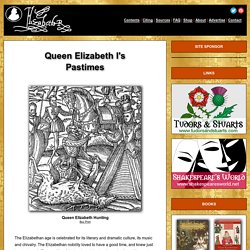
The Elizabethan nobility loved to have a good time, and knew just how to have it. The wealthy of the land would entertain each other with great banquets of rich foods, wine, music and dancing. They would play games against each other, play sports such as tennis or bowls, and they would ride and hunt. Women too would participate in some of these sports, aswell as play musical instruments, draw, sew and embroider. When Queen Elizabeth was not busy with matters of state, she too would enjoy some of these pleasures.
Queen Elizabeth's HorseBuy Print Elizabeth loved to horse ride. Elizabeth also loved to hunt. Elizabethan leisure - Wikipedia. In the Elizabethan era (1558–1603), there was a wide range of leisure activities entertaining both the nobility and the common classes.

Among these leisure activities were animal fighting, team sports, individual sports, games, dramatics, music and the arts. Blood sports[edit] A variety of pastimes which would now be considered blood sports were popular. Cock fighting was a common pastime, and the bets on this game could amount to thousands of pounds, an exorbitant amount of money in those days, and many respectable gentlemen lost all their money this way. [citation needed] Henry VIII had a royal cockpit built at one of his palaces. Young boys on Shrove Tuesday would normally bring in their own fighting rooster and would spend the afternoon at school placing bets on which rooster would win[citation needed]. There were other common animal sports: bear-baiting, bullfighting, dog fighting,[1] and cock throwing.
Hunting[edit] Elizabethan England Music,Elizabethan Era Musical Instrumnents History and Facts. People during the Elizabethan era considered music as one significant part of their life.
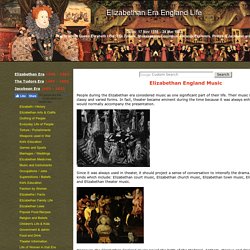
Their music is famous because of its classy and varied forms. In fact, theater became eminent during the time because it was always enhanced by music that would normally accompany the presentation. Since it was always used in theater, it should project a sense of conversation to intensify the drama. Life in Elizabethan England 45: Filling the Time. As we know, there is nothing as dangerous as a bored nobleman (unless it's an idle soldier).
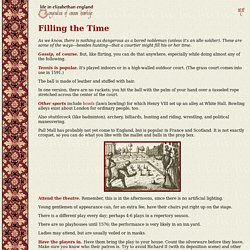
These are some of the ways—besides hunting—that a courtier might fill his or her time. Gossip, of course. But, like flirting, you can do that anywhere, especially while doing almost any of the following. Tennis is popular. It's played indoors or in a high-walled outdoor court. The ball is made of leather and stuffed with hair. In one version, there are no rackets; you hit the ball with the palm of your hand over a tasseled rope stretched across the center of the court.
Other sports include bowls (lawn bowling) for which Henry VIII set up an alley at White Hall. Also shuttlecock (like badminton), archery, billiards, hunting and riding, wrestling, and political maneuvering. Pall Mall has probably not yet come to England, but is popular in France and Scotland. ELIZABETHAN MUSIC.
Elizabethan music was so popular that every Nobleman employed his own musicians.
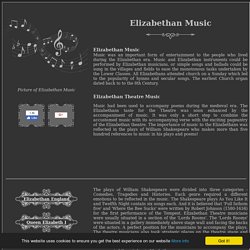
Even Middle Class households employed at least one servant who could also play a musical instrument. Anyone who belonged to these classes were expected to be able to perform on an instrument and read music on sight. Music and Song lyrics were printed during the Elizabethan era but these were sold as separate documents. The Elizabethan composer John Dowland (1563-1626), a University Graduate in Music, published his ' First Booke of Songes or Ayres' in 1597.
Elizabethan Entertainment. For additional information about the sporting forms of entertainment click the following Link to Elizabethan Sportsand for information about Elizabethan plays click Elizabethan Theatre Elizabethan Entertainers The Names and Types of Elizabethan Entertainment were as follows: Jesters - A fool or buffoon at Elizabethan courtsMummers - A masked or costumed merrymaker or dancer especially at a festivalMinstrels - Travelling musician who sang of legends (declined in the Elizabethan era)Troubadours - Travelling musician who sang of courtly love (declined in the Elizabethan era)Acting Troupes - Travelling actorsJugglers - Also used tricks, deception, or fraud.
